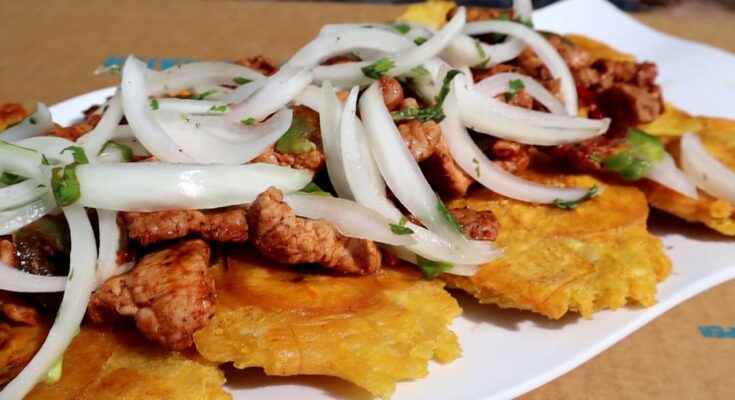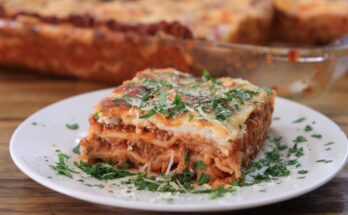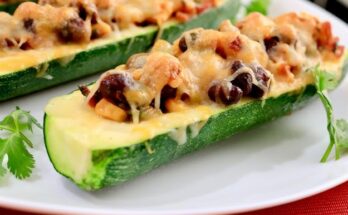Tostones Recipe: Tostones are a beloved staple in Latin American and Caribbean cuisine. If you’ve never tried one, imagine a crispy, golden, twice-fried disc made from green plantains that’s crunchy on the outside and tender on the inside. These savory snacks are as versatile as French fries and just as addictive. Unlike sweet plantains (maduros), tostones are made with unripe green plantains, giving them a starchy, slightly nutty flavor that pairs beautifully with savory seasonings or dipping sauces.
Tostones are often enjoyed as a side dish, appetizer, or even as a base for creative toppings, much like a mini tostada or crostini. They’re especially popular in Puerto Rican, Dominican, Cuban, and Colombian kitchens, where they’re often found alongside rice and beans, grilled meats, or seafood dishes.
Origins and Cultural Significance
Tostones aren’t just delicious—they’re deeply rooted in cultural traditions. The name “tostones” comes from the Spanish verb tostar, meaning “to toast” or “to fry,” which refers to their twice-fried cooking method. Their preparation is a communal affair in many Latin households, where the entire family may gather in the kitchen to slice, smash, and fry plantains together.
Though you’ll find similar recipes across many countries, each region adds its unique twist. In the Dominican Republic, they might be topped with garlic mojo, while in Puerto Rico, you’ll often see them paired with a tangy mayo-ketchup sauce. No matter the variation, they all share the same crunchy, satisfying texture that makes them irresistible.
Ingredients Needed for Tostones
Key Ingredients
The beauty of tostones lies in their simplicity. You don’t need a long list of ingredients to get started—just a few pantry staples and you’re good to go.
- Green plantains – The star of the show. Make sure they’re firm and unripe. Ripe ones will turn out soft and sweet, which is not what you want for tostones.
- Vegetable oil – For frying. Canola, corn, or peanut oil work great because they have high smoke points.
- Salt – A pinch of salt right after frying enhances the flavor.
- Garlic (optional) – Crushed garlic mixed with water or oil can be brushed on for added flavor.
Optional Additions for Extra Flavor
While traditionalists stick to the basics, adding a few extras can elevate your tostones game.
- Adobo seasoning or garlic powder – Sprinkle after frying for an extra flavor kick.
- Lime juice – A light squeeze right before serving adds brightness.
- Cilantro – Chopped fresh cilantro sprinkled on top for garnish and freshness.
Kitchen Tools and Equipment
Basic Tools
No fancy kitchen gadgets are required to make tostones. Here’s what you’ll need:
- Sharp knife – For slicing the plantains.
- Cutting board – A sturdy surface to work on.
- Heavy-bottom skillet or frying pan – Cast iron or non-stick both work well.
- Tongs or slotted spoon – For handling the plantains safely while frying.
- Paper towels – For draining excess oil.
Useful Extras for Easier Preparation
Some additional tools can streamline the process and improve your results.
- Tostonera – A toston press that helps smash the plantain rounds evenly. If you don’t have one, use the bottom of a cup, jar, or flat spatula.
- Thermometer – Useful for maintaining the ideal oil temperature (around 350°F or 175°C).
- Garlic brush or pastry brush – For brushing flavored oil or garlic water over the tostones for added zest.
Choosing the Right Plantains
Green vs. Ripe Plantains
When it comes to tostones, green plantains are non-negotiable. Ripe plantains, which are yellow with black spots, are much sweeter and softer. Green plantains, on the other hand, are firm, starchy, and slightly bitter—ideal for frying into a crisp, savory snack.
So, how do you tell the difference? Look for plantains that are completely green, firm to the touch, and free of blemishes. A tiny bit of yellowing is okay, but avoid anything with major soft spots or blackened peels.
Tips for Picking the Best Plantains
- Firmness is key – The harder, the better. This ensures they’ll hold up during the smashing process.
- Size matters – Choose medium to large plantains for more uniform slices.
- Avoid bruises or deep cracks – These can affect texture and cook unevenly.
Step-by-Step Guide to Making Tostones
Step 1: Peel and Cut the Plantains
Start by slicing off both ends of each plantain. Use a knife to score the skin lengthwise in 3 or 4 places, then peel away the thick skin with your fingers or a spoon. Cut the peeled plantains into 1-inch chunks—these will be the rounds you fry and flatten.
Peeling green plantains can be tricky because of their thick skin and starchy texture. If the peel resists, soak the plantains in warm water for 10 minutes before peeling. This softens the skin just enough to make things easier.
Step 2: First Fry – Cooking the Rounds
Once your plantain slices are ready, it’s time for the first fry. This initial cooking step softens the plantains and preps them for flattening. Heat your oil in a heavy skillet over medium-high heat until it reaches about 350°F (175°C). If you don’t have a thermometer, test it by dropping a tiny piece of plantain in—it should sizzle immediately.
Carefully add the plantain slices in a single layer without overcrowding the pan. Fry for about 3–4 minutes on each side, or until the plantains turn a light golden color and begin to soften. Don’t aim for crispiness yet—you’re just cooking them enough so they can be smashed without falling apart.
Use tongs or a slotted spoon to remove the plantains and transfer them to a paper towel-lined plate. Let them cool for a minute or two before moving to the next step.
Step 3: Smash the Plantains
Now comes the fun part—smashing! This is what gives tostones their classic flattened shape and extra surface area for crisping up. If you have a tostonera, place one cooked slice inside and press it down firmly. Don’t have one? No problem. Use the bottom of a glass, a flat spatula, or even a can—anything with a flat surface will do.
You’re aiming for a disc about ¼ inch thick. Try to make them as even as possible for consistent frying. If the plantains stick to your press or tool, lightly oil the surface or use a small piece of plastic wrap as a barrier.
Once flattened, set the tostones aside on a plate lined with parchment or a clean kitchen towel. You’re now ready for round two of frying!
Step 4: Second Fry – Crisping to Perfection
For the second fry, heat the oil again (if needed) and bring it back to around 350°F (175°C). Carefully add the smashed plantains in batches—don’t overcrowd the pan or they’ll get soggy instead of crispy.
Fry each side for about 2–3 minutes or until golden brown and crispy. You should see small bubbles forming around the edges, and the plantains will become firmer to the touch.
Once they’re done, transfer the tostones to a paper towel-lined plate to drain excess oil. This is your moment of glory—they should be crispy, golden, and absolutely irresistible.
Immediately sprinkle with salt while they’re still hot so it sticks. You can also brush them with garlic oil or dip them briefly in garlic water for a flavor boost, a technique popular in many Caribbean households.
Step 5: Seasoning and Serving
Seasoning tostones is where you can let your personality shine. While a simple sprinkle of sea salt works wonders, here are some creative ideas to elevate your tostones game:
- Garlic mojo – A mix of crushed garlic, olive oil, and lemon juice brushed on top.
- Spicy mayo – Blend mayo with sriracha or hot sauce for a creamy, tangy dip.
- Mayo-ketchup sauce – A Puerto Rican favorite. Mix equal parts mayonnaise and ketchup with a touch of garlic powder and vinegar.
- Avocado dip – Mash ripe avocado with lime juice and salt for a tropical guac-style pairing.
Serve your tostones hot and crispy. They pair beautifully with grilled meats, seafood, beans, or just about any Latin-inspired dish. You can even top them like mini tostadas—with black beans, pulled pork, or cheese. The possibilities are endless!
Serving Suggestions
Dipping Sauces and Accompaniments
Tostones shine even brighter when paired with the right dips and sides. Here are a few favorite combos:
- Garlic sauce (mojo de ajo) – Perfect for drizzling or dipping.
- Chimichurri – The herbaceous kick of chimichurri complements the tostones’ crispiness.
- Spicy mango salsa – Sweet, spicy, and tangy—great for island vibes.
- Cilantro-lime aioli – A creamy dip with a zesty punch.
- Classic guacamole – Always a winner for dipping or topping.
You can also serve tostones alongside protein-packed dishes like:
- Grilled chicken or steak
- Shrimp skewers or ceviche
- Fried fish or cod
- Pulled pork or carnitas
They’re also amazing as a party appetizer or game-day snack. Put out a tray of tostones with various dips and watch them disappear!
Pairing Ideas for Meals
If you’re planning a full meal, consider serving tostones with:
- Arroz con pollo – The crispy tostones are a perfect contrast to this comforting rice dish.
- Black beans and rice – A classic Cuban combo, made even better with a few tostones on the side.
- Ensalada de aguacate – A light avocado salad to balance the rich fried plantains.
- Mofongo or carne guisada – Hearty stews and mashed plantains love a crunchy partner like tostones.
You can even turn tostones into mini sliders or canapés by topping them with pulled meat, avocado, or cheese—get creative!
Storing and Reheating Tostones
How to Store Leftovers
If you happen to have leftover tostones (though it’s rare because they’re that good!), you’ll want to store them properly to maintain their texture and flavor. First, let them cool completely to room temperature—never store them while they’re still warm or they’ll become soggy.
Place them in an airtight container lined with a paper towel to absorb any remaining moisture. Stack them with parchment paper in between layers to prevent sticking. Properly stored, tostones will stay fresh in the refrigerator for up to 3 days.
Avoid freezing fully cooked tostones, as the double-frying process doesn’t freeze well. However, if you want to make them ahead of time, you can complete the first fry, smash the plantains, and then freeze them in a single layer. When ready to eat, just thaw slightly and do the second fry.
Best Reheating Methods
Reheating tostones the right way is key to bringing back that crispy magic. Here are the best methods:
- Air fryer – This is the ideal tool. Set it to 375°F (190°C) and heat the tostones for 3–5 minutes. They’ll come out almost as crispy as fresh.
- Oven or toaster oven – Preheat to 400°F (200°C) and reheat on a baking sheet for 8–10 minutes, flipping halfway through.
- Skillet – Reheat in a lightly oiled pan over medium heat for 2–3 minutes on each side.
- Microwave – Not recommended, as it tends to make tostones soft and chewy rather than crispy.
A good tip: when reheating, brush them lightly with oil before popping them in the oven or air fryer for that fresh-out-of-the-pan crunch.
Common Mistakes to Avoid
Overripe Plantains
One of the biggest mistakes you can make when preparing tostones is using overripe plantains. Ripe ones are better suited for maduros, which are sweet and soft. Tostones require firm, green plantains to achieve that signature crispy texture and savory taste.
Using overripe plantains will result in mushy, overly sweet rounds that don’t hold their shape when flattened or fried a second time. Always check for firmness and a dark green peel before starting your recipe.
If you’re unsure, gently press your thumb into the plantain. If it gives easily, it’s too ripe. You want a plantain that resists pressure and has no yellow streaks.
Improper Oil Temperature
Another common error is frying at the wrong oil temperature. Too low, and your tostones will absorb excess oil and turn greasy. Too high, and they’ll burn on the outside before cooking through.
The sweet spot is 350°F (175°C). If you don’t have a thermometer, drop a tiny piece of plantain into the oil—if it sizzles steadily (not violently), you’re good to go.
Always let the oil return to temperature between batches. Crowding the pan cools the oil quickly, so fry in small batches and give your oil a moment to recover before adding more plantains.
Nutritional Value of Tostones
Calories and Macronutrients
Tostones may be a fried snack, but they still offer some nutritional value—especially if enjoyed in moderation. A serving of 3–4 tostones (fried in vegetable oil) typically contains:
- Calories: 200–250
- Carbohydrates: 30–35g
- Fat: 10–15g
- Protein: 1–2g
- Fiber: 2–3g
Plantains are rich in complex carbohydrates and dietary fiber, making them more filling than standard fried potatoes. They also provide essential vitamins and minerals like:
- Vitamin A
- Vitamin C
- Vitamin B6
- Potassium
- Magnesium
Of course, the frying process adds fat and calories, but if you’re mindful of portion size or opt for air frying, tostones can be part of a balanced diet.
Health Considerations
While tostones are naturally gluten-free and vegan-friendly, they are still a fried food—so balance is key. If you’re watching your fat intake, try pan-frying with minimal oil or using an air fryer for a lighter version.
For a healthier twist, pair tostones with nutrient-dense dips like hummus, guacamole, or a bean-based salsa. You can also use avocado oil or olive oil for frying, which are higher in heart-healthy fats.
FAQs about Tostones Recipe
What are tostones?
Tostones are twice-fried green plantains that are crispy on the outside and soft on the inside. They’re a staple in many Latin American and Caribbean cuisines.
What kind of plantains should I use?
Use green (unripe) plantains for tostones. Ripe plantains are too soft and sweet for this recipe.
How do I keep tostones crispy?
After frying, place the tostones on a paper towel-lined plate and sprinkle with salt immediately. Avoid stacking them to maintain crispiness.
Can I make tostones in an air fryer?
Yes, tostones can be air-fried. Flatten them after the first round of cooking, spray with oil, and air fry until golden brown.
What oil is best for frying tostones?
Use a neutral oil like canola, vegetable, or peanut oil for deep or shallow frying.
Do I need a tostonera (plantain press)?
It helps, but it’s not required. You can use the bottom of a glass, a plate, or a flat spatula to press the plantains.
Can tostones be made ahead of time?
Tostones taste best fresh, but you can partially fry and flatten them ahead of time. Re-fry them just before serving.
What can I serve with tostones?
They pair well with garlic sauce (mojo), guacamole, salsa, shredded meat, or beans. They also make a great snack or appetizer.
Are tostones gluten-free and vegan?
Yes! Tostones are naturally gluten-free and vegan, making them a great option for most dietary needs.
How thick should I slice the plantains?
Cut the plantains into 1-inch thick slices for the perfect tostone texture after flattening and frying.
Conclusion
Tostones are more than just a snack—they’re a slice of Latin culture, a crunchy comfort food, and a surprisingly easy dish to make at home. With just a few green plantains, some oil, and a pinch of salt, you can whip up a batch of golden, twice-fried perfection that’ll have everyone coming back for seconds (and thirds).
Whether you’re serving them with a zesty garlic sauce, layering them with toppings, or enjoying them straight out of the pan, tostones are endlessly versatile and undeniably satisfying. So next time you spot green plantains at the market, grab a few—you’re just a couple of fries away from culinary greatness.



